MARIANI’S
Virtual Gourmet
April
9, 2017
NEWSLETTER
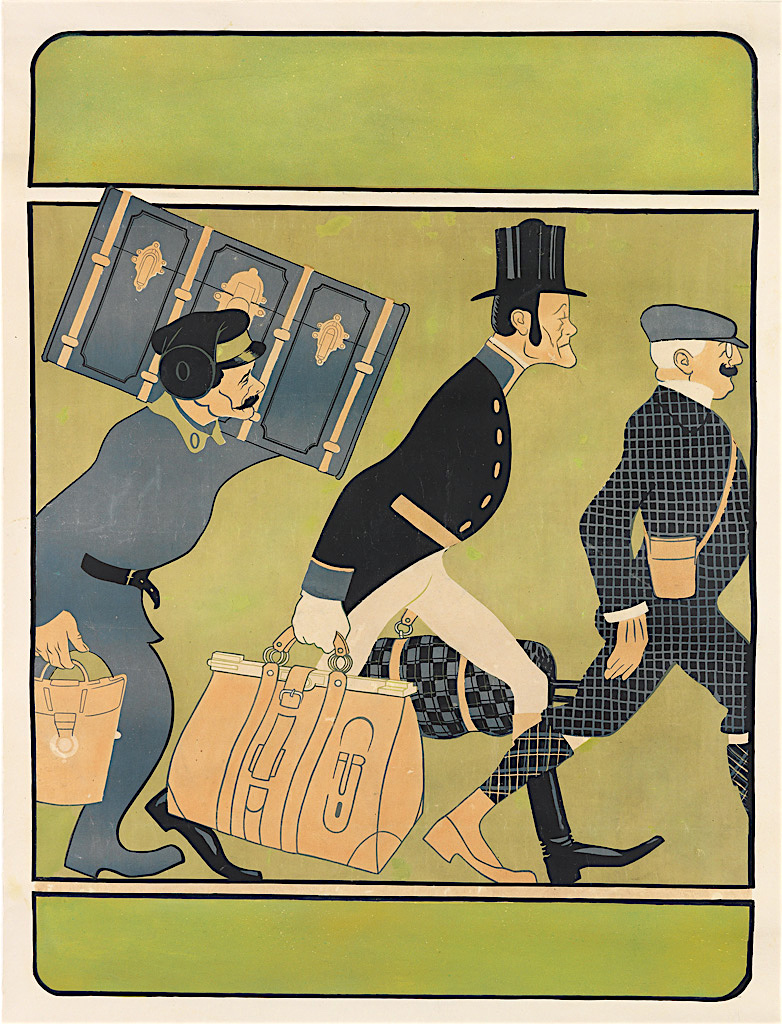
❖❖❖
IN THIS ISSUE
DINING OUT IN DUBLIN,
Part One
By John Mariani
NEW YORK CORNER
OCEANA
By John Mariani
NOTES FROM THE WINE CELLAR
PURPLE HEART WINES
By John Mariani
❖❖❖
DINING OUT IN DUBLIN
By John Mariani
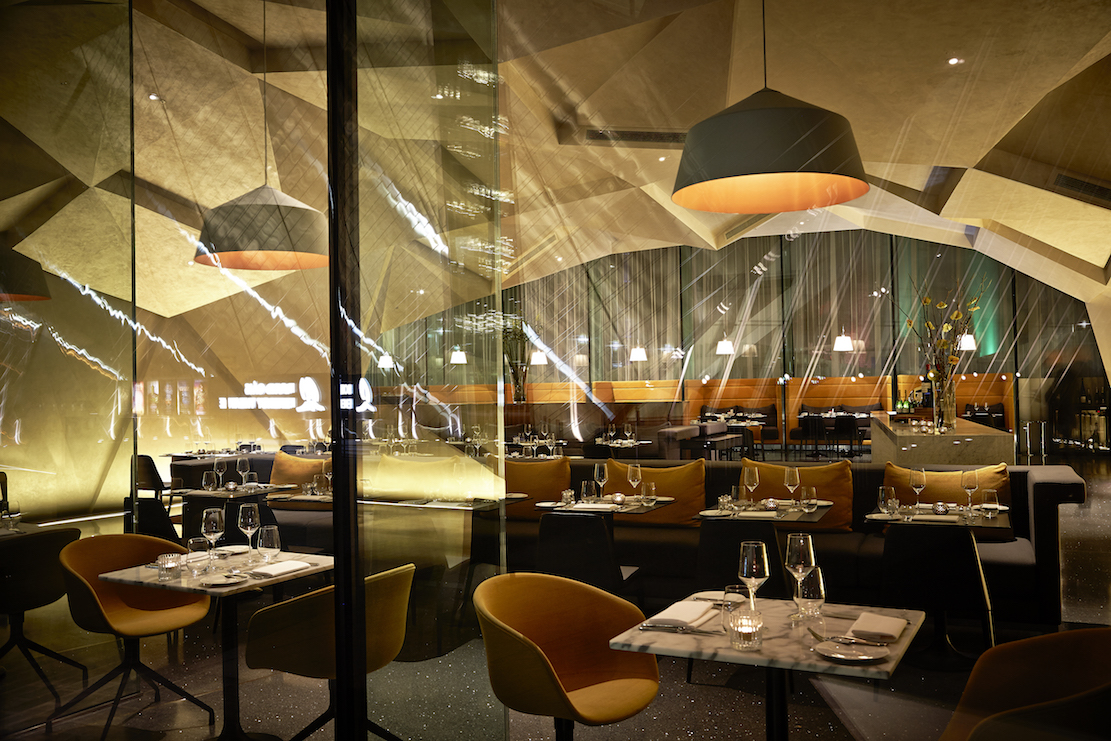
Brasserie at the Marker Hotel, Dublin
If the photo above doesn’t quite conform to your idea of a Dublin restaurant, rest assured that there are plenty of pubs, fish and chips shops, and traditional Irish restaurants that will. But The Brasserie, set within the ultra-modern Marker Hotel on the fast-growing north shore of the Liffey River, is very much indicative of how far and how fast Dublin’s dining scene has evolved since the turn of the century. Let me tell you about a few signal places to go right now.
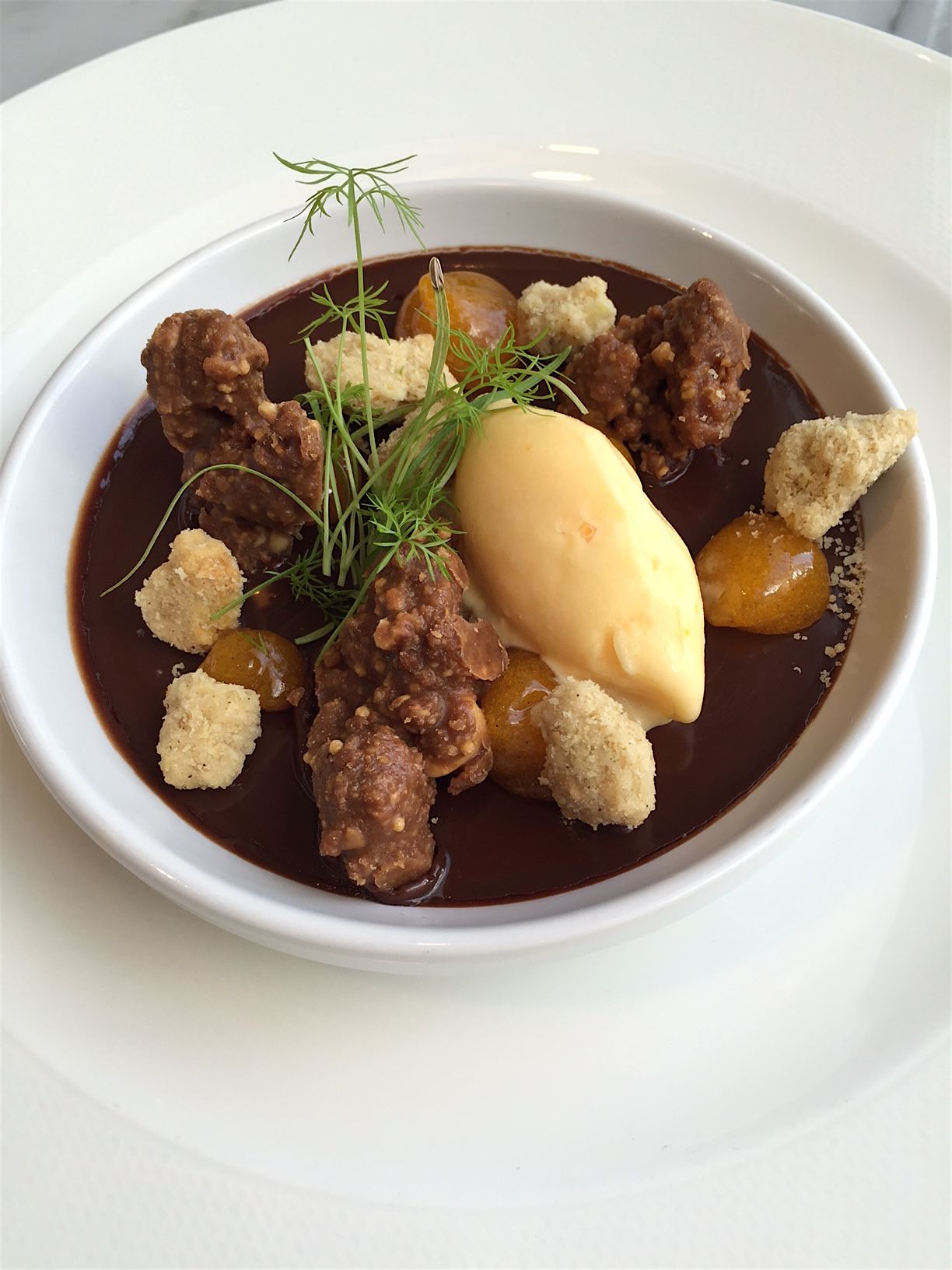 THE BRASSERIE
THE BRASSERIE
The Marker Hotel
Grand Canal Square, Docklands
353-1-687-5100
Nothing better shows the leaps
that Dublin north of the Liffey has made than The
Marker Hotel, whose glass-sheathed 21st century
design takes full advantage of its landscape. Just
187 rooms makes this an ideal modern hotel for
both business and pleasure, its rooms spacious,
done in contrasts of off-white and brilliant
colors, the large bathrooms excellent and well
lighted, the free wi-fi works well, and the
reception and concierge staff could not be more
accommodating.
The Brasserie soaks up the sun
and the light from, to evoke James Joyce,
“rivverrun ... from swerve of shore to bend of
bay” in the fast-developing Grand Canal section of
the Docklands area. There’s a handsome long bar
with a swank lounge area set with fine Panton
chairs; soft chandeliers hang above each table,
and the use of angular, space-age colored ceiling
blocks and buffers keep the room from dwarfing
diners and also keep the noise down. This could be
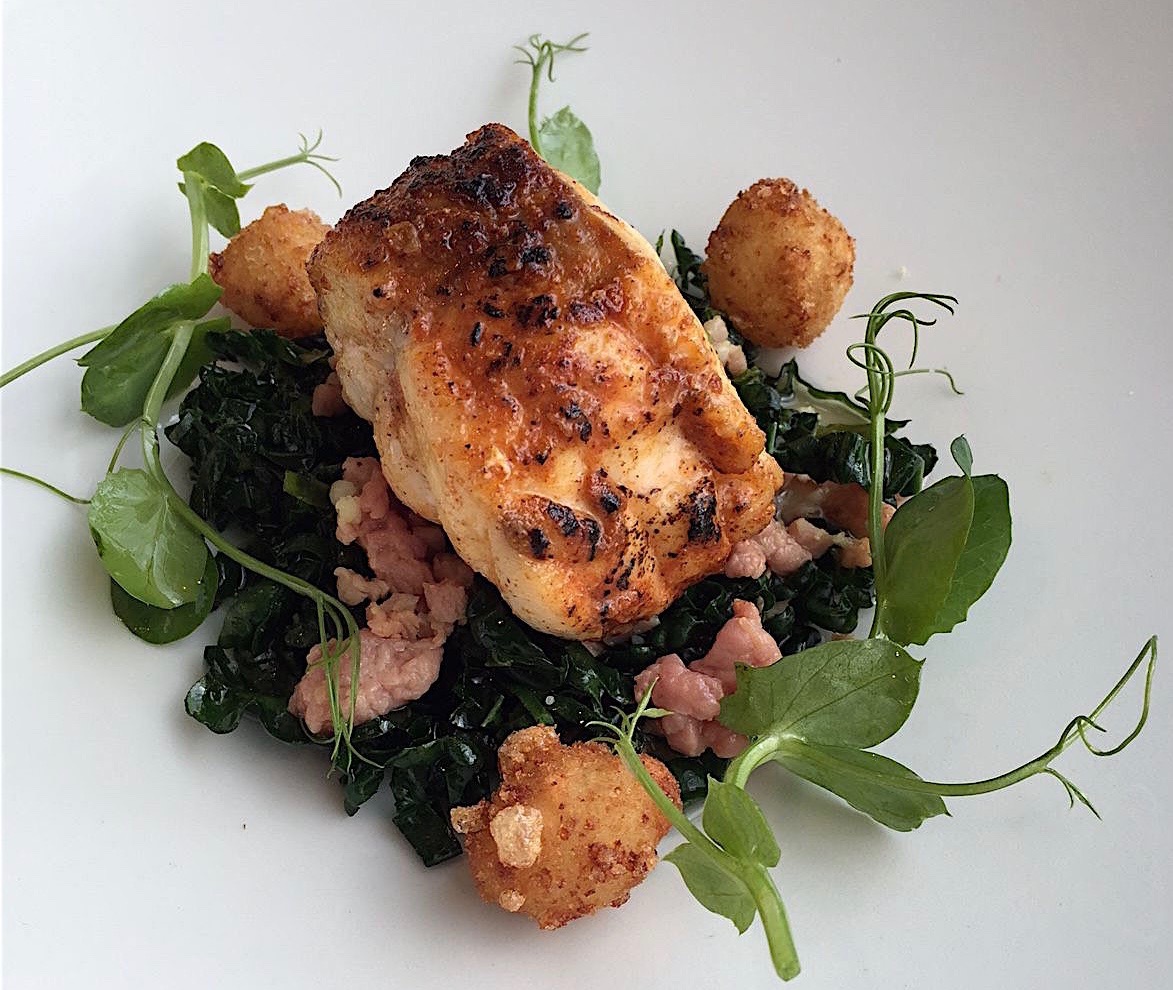 the
officers’ dining room on the Star Trek ship Enterprise.
the
officers’ dining room on the Star Trek ship Enterprise.
The excellent young staff is
genial in the most affable Irish way,
knowledgeable and eager to grant requests. The
wine list is first rate, with depth and breadth
throughout, with prices not inexpensive but not
outrageous either.
Executive Chef
Gareth Mullins exults in the quality of the
products used (without needing to name every farm
and fishing dock from which he sources),
delivering beautiful dishes whose deep elemental
flavors are enhanced by well-reduced sauces—not
too much—in dishes like roasted pigeon with
grilled chicory, carrot spaghetti, cauliflower
cream, and a truffle and citrus vinaigrette.
Barbecued monkfish (right) comes with black
cabbage, baby onions and a sweet bacon dressing.
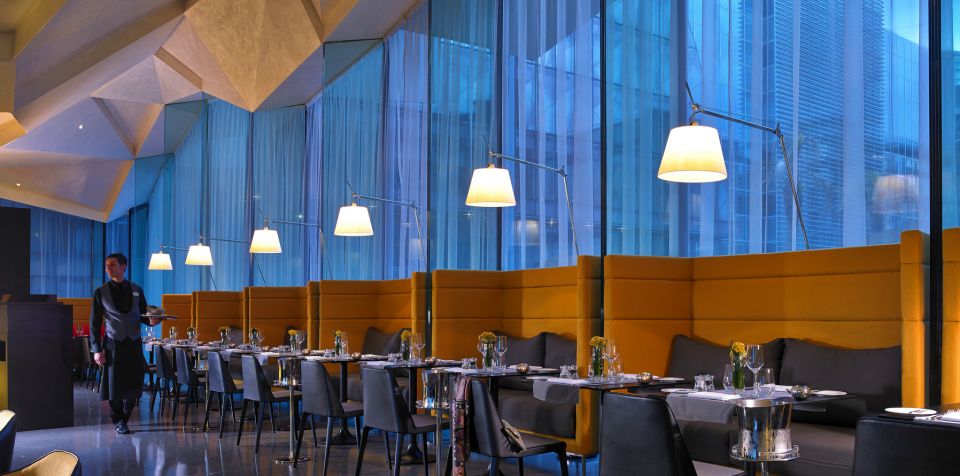 For
dessert the orange and dark chocolate crèmeux
is dressed with apricot and orange sauce, orange
ice cream and praline crumble, while a purple
velvet cake comes lavished with vanilla cream
mousse, blackberry and tarragon compote, and
vanilla ice cream.
For
dessert the orange and dark chocolate crèmeux
is dressed with apricot and orange sauce, orange
ice cream and praline crumble, while a purple
velvet cake comes lavished with vanilla cream
mousse, blackberry and tarragon compote, and
vanilla ice cream.
The Brasserie already ranks
with the best restaurants in Dublin and serves as
a lesson in what truly contemporary Irish cooking
can be. It shouldn’t be missed.
Open daily for breakfast, lunch and dinner. At
dinner à la carte prices run €8-12 for starters,
€18-38 for main dishes. Lunch fixed priced at 2
courses for €26, three for €30.
L’ECRIVAIN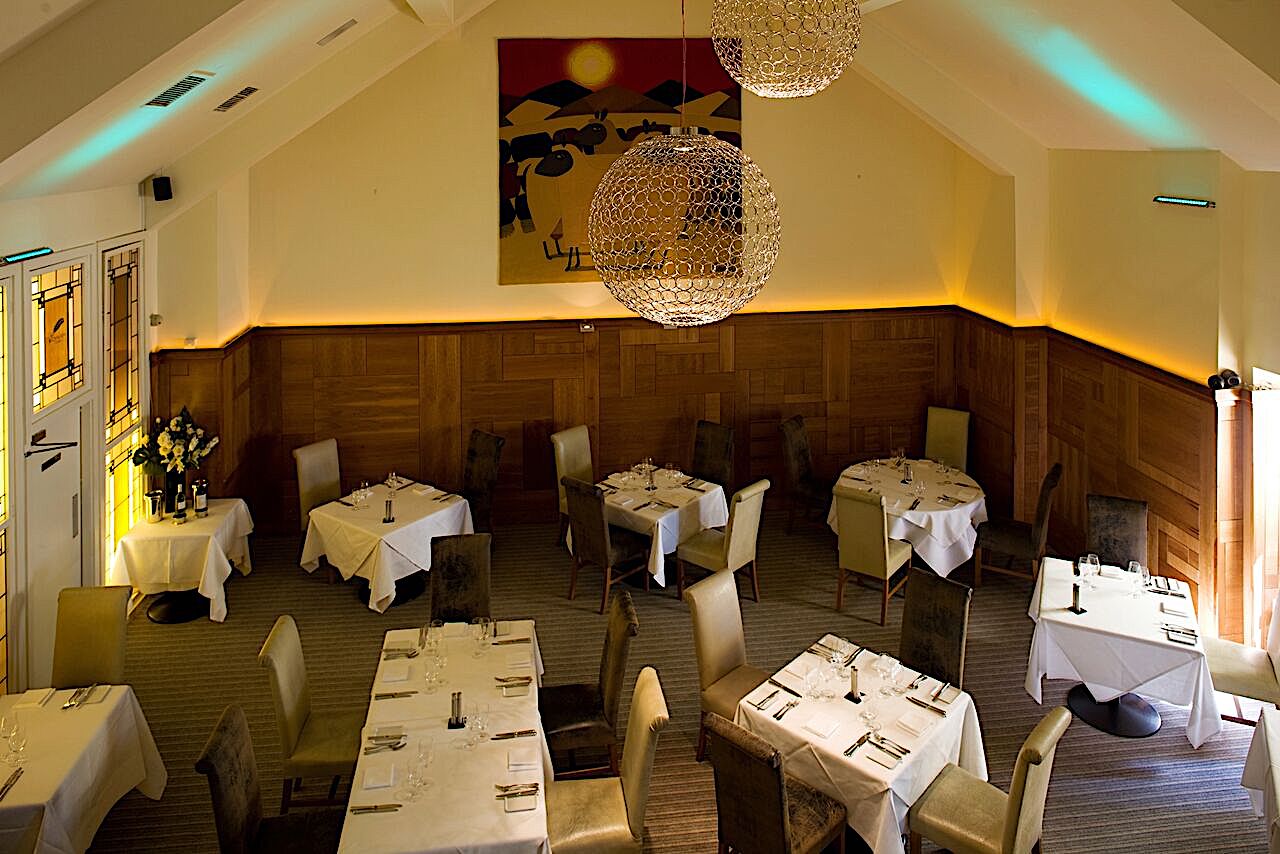
109A Lower Baggot Street
351-1-661-1919
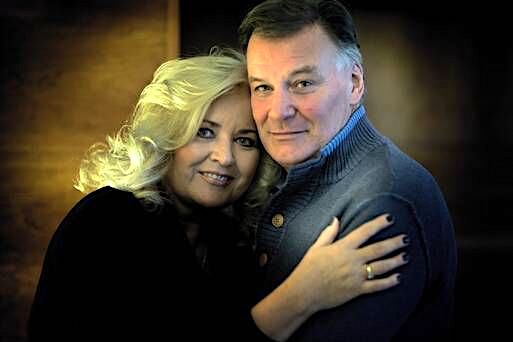 And after
all these years, the place does banner business,
not least because of the attention the Clarkes and
the staff show to both regulars and newcomers. Sallyanne
seems as ever joyful at greeting guests, telling
her story, nudging you to try this or that new
dish or wine, while Derry, with head chef Tom
Doyle, has never flagged in applying the rigors of
French techniques to the very best Irish products. Kudos,
too, for a superb wine list with plenty of
excellent choices under €75.
And after
all these years, the place does banner business,
not least because of the attention the Clarkes and
the staff show to both regulars and newcomers. Sallyanne
seems as ever joyful at greeting guests, telling
her story, nudging you to try this or that new
dish or wine, while Derry, with head chef Tom
Doyle, has never flagged in applying the rigors of
French techniques to the very best Irish products. Kudos,
too, for a superb wine list with plenty of
excellent choices under €75.
I could do without the New Age
piano music (a droning sample of which you get
when you telephone the restaurant), and I can also
do without the alphabet soup of allergies noted
for every dish on the menu.
As part of the €75 Seasonal
Dinner Menu you get amuses to
pop in the mouth.
I, there last fall, was the happy recipient
of dishes like perfectly roasted scallops with
parsley root, trumpet mushrooms, crispy chicken
skin for texture and dashi as a broth base. Tomato
and goat’s curd came with the welcome addition of
lobster, basil, pickled onions, and a tomato
vinaigrette to add just the right amount of acid
to the dish.
Impeccable cooking technique informed a
luscious breast and leg of squab with beets,
endive, tangy-sweet blackberries,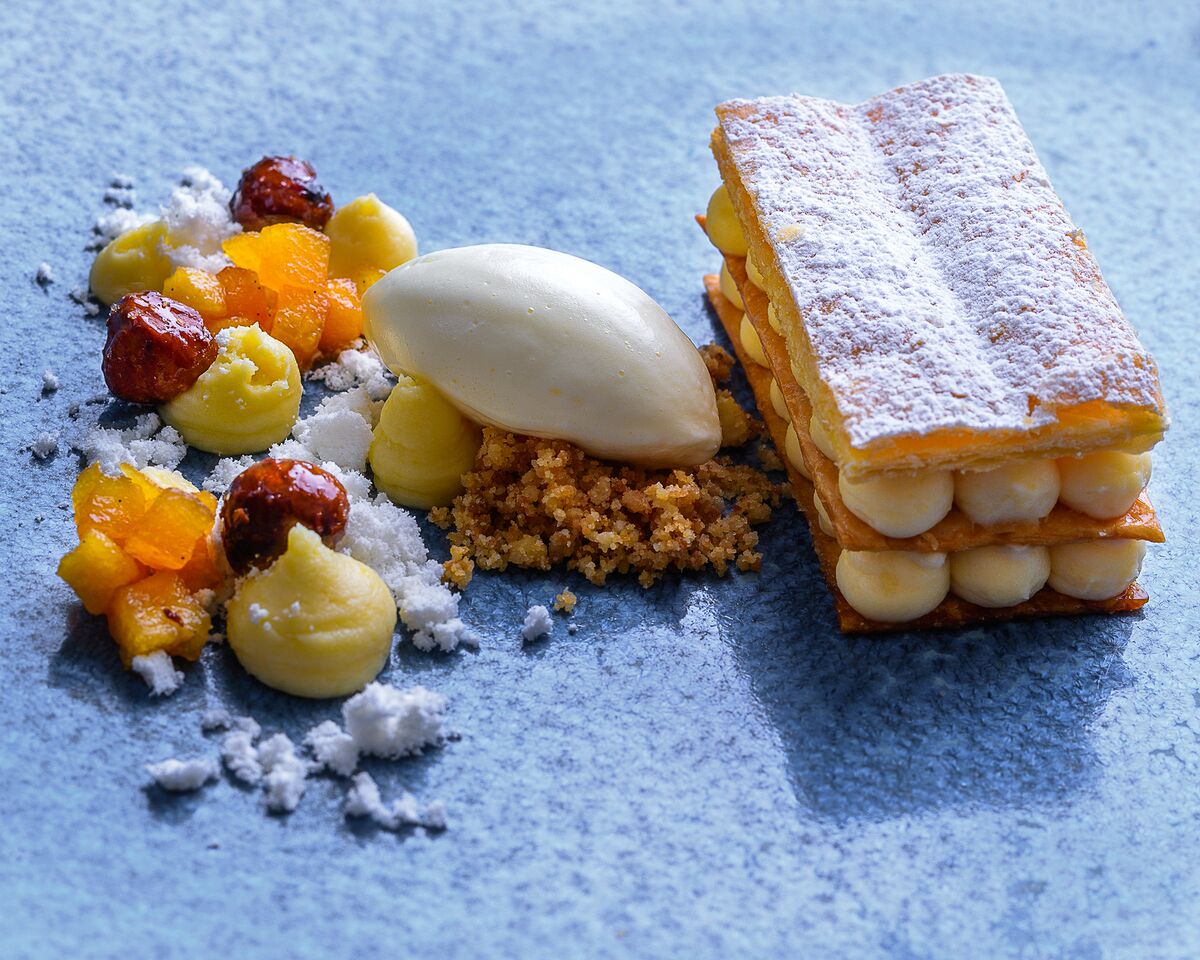 and a
lovely potato mousse with the squab’s jus. Also
indicative of how a long tenure gets things right
was a gently roasted cod with charred gem lettuce,
sea vegetables and oyster cream.
and a
lovely potato mousse with the squab’s jus. Also
indicative of how a long tenure gets things right
was a gently roasted cod with charred gem lettuce,
sea vegetables and oyster cream.
L’Ecrivain is the kind of
restaurant where you’d never refuse the cheese
course—a selection of Irish and French artisanal
varieties—and I enjoyed two marvelous desserts:
and opera cake with salted caramel ice cream, and
a sumptuous dish of Mirabelle plums with a little
doughnut, cream, a tuile cookie, and vanilla ice
cream, as I sipped a Monbazillac 2011.
That L’Ecrivain has been an
inspiration to every good restaurant in Dublin is
obvious from the way other chefs speak of it. Now,
after two decades, it still is.
Open for lunch Wed.-Fri., dinner Mon.-Sat. Fixed
price lunch for 3 courses €45, two for €35; Seasonal
menu for three courses €75; tasting menu €90;
ANANDA
Sandyford Road
Dundrum Town Centre
353-1-296-0099
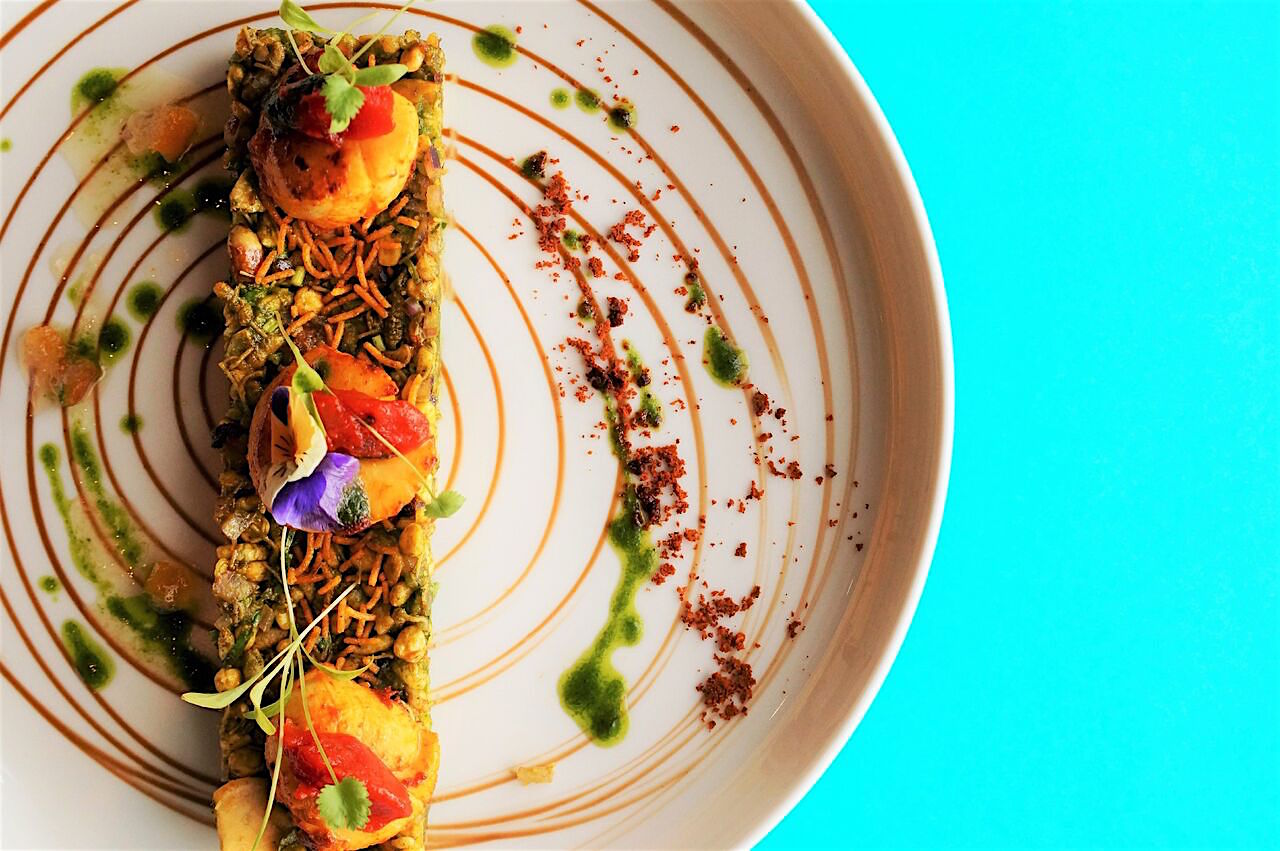 Having
noted how Dublin’s gastronomy is now
international, it should come as no surprise
that Ananda, located outside of town in a vast
shopping mall, is one of the best Indian
restaurants in Europe, not least for its
modernity, color, décor and attention to
service, thanks to owner Asheesh Dewan, who was a
college mate to Chef Sundeep Bhagat.
Having
noted how Dublin’s gastronomy is now
international, it should come as no surprise
that Ananda, located outside of town in a vast
shopping mall, is one of the best Indian
restaurants in Europe, not least for its
modernity, color, décor and attention to
service, thanks to owner Asheesh Dewan, who was a
college mate to Chef Sundeep Bhagat.
The place has won numerous
awards both in and outside of Ireland, and
deservedly so, for Indian cuisine of this high
order is not what you’ll still find at the
old-fashioned curry houses that dot Dublin. The
food is beautifully presented and tastes every bit
as good as it looks, beginning with so many
starters that it’s difficult to turn away from
them and go on to main courses. There is goat’s
cheese tart tikki with savory potatoes (€8.50)
and duck two ways (below)—smoked breast and crisp
potted leg—with apple cracker and orange jam
(€12.50). Pray they always keep the Mumbai-style
scallops with tomato ragôut (€14.50) and the juicy
kurkura
lamb kebabs with chestnut and rocket pesto,
eggplant fries, chili and garlic (€12.50).
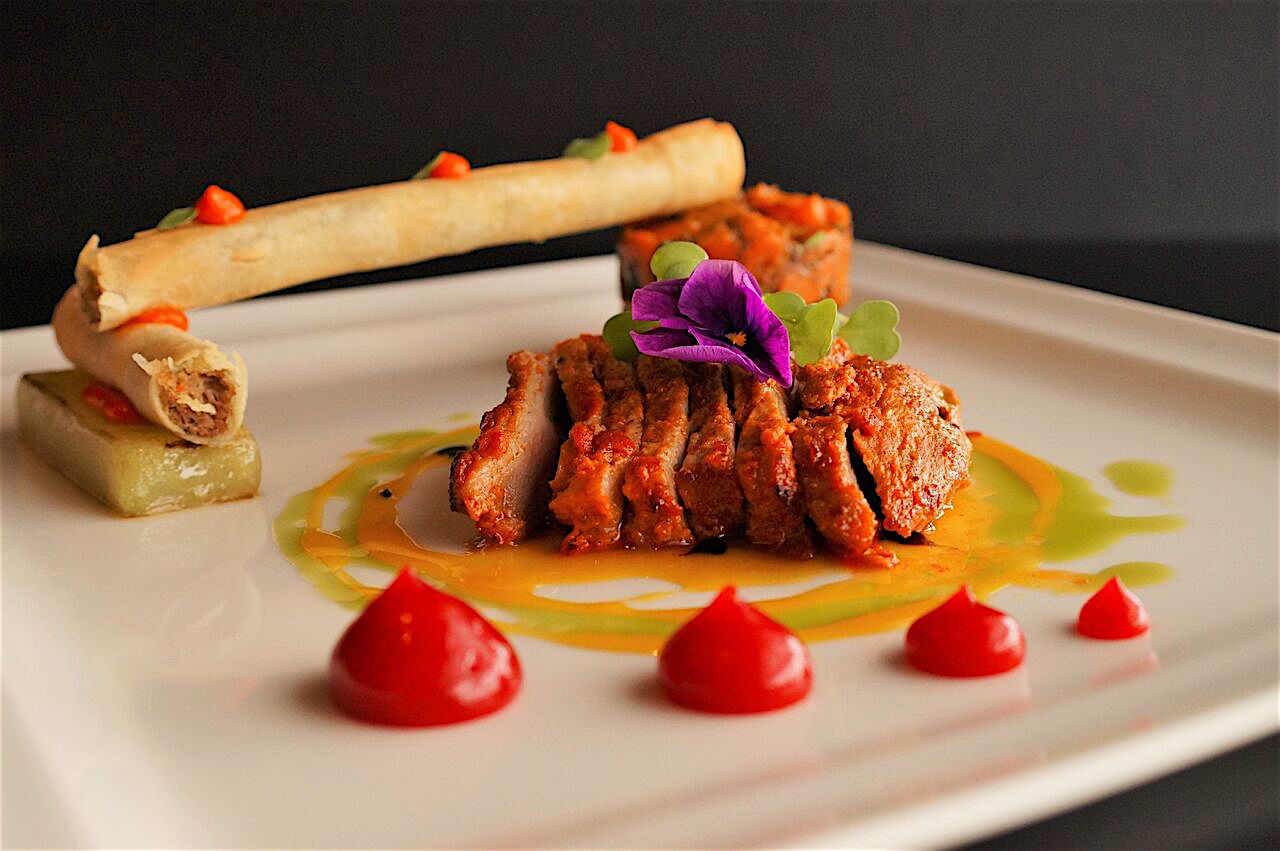 But
do go on to the main courses and you’ll be
rewarded with aromatically spiced dishes, some
mild, some assertive, like Jhinga neel
giri of wild Indian Ocean jumbo prawns in a
curry leaf, with coriander and coconut korma (€25.50).
One of the specials among many special dishes at
Ananda is the signature Sigri lagosta,
tandoor-roasted lobster with a hint of cardamom
and the fragrance of masala rice (€35.50). There
is much more to try, including many vegetarian
dishes—everything I had showed expertise in
cooking timing—and, as you’d expect, the Indian
breads are addictive. Desserts go way beyond the
usual rosewater creams, and are equally as lovely
and complex as what precedes them.
But
do go on to the main courses and you’ll be
rewarded with aromatically spiced dishes, some
mild, some assertive, like Jhinga neel
giri of wild Indian Ocean jumbo prawns in a
curry leaf, with coriander and coconut korma (€25.50).
One of the specials among many special dishes at
Ananda is the signature Sigri lagosta,
tandoor-roasted lobster with a hint of cardamom
and the fragrance of masala rice (€35.50). There
is much more to try, including many vegetarian
dishes—everything I had showed expertise in
cooking timing—and, as you’d expect, the Indian
breads are addictive. Desserts go way beyond the
usual rosewater creams, and are equally as lovely
and complex as what precedes them.
If Ananda’s has not the finest
wine list in any Indian restaurant in Europe, I’ve
not seen better, with many wines by the glass at
reasonable prices and a very international
selection that goes on for pages.
Open daily for lunch and dinner. There is a
pre-theater dinner at €27 and lunch
at €20-21.
THE
GREENHOUSE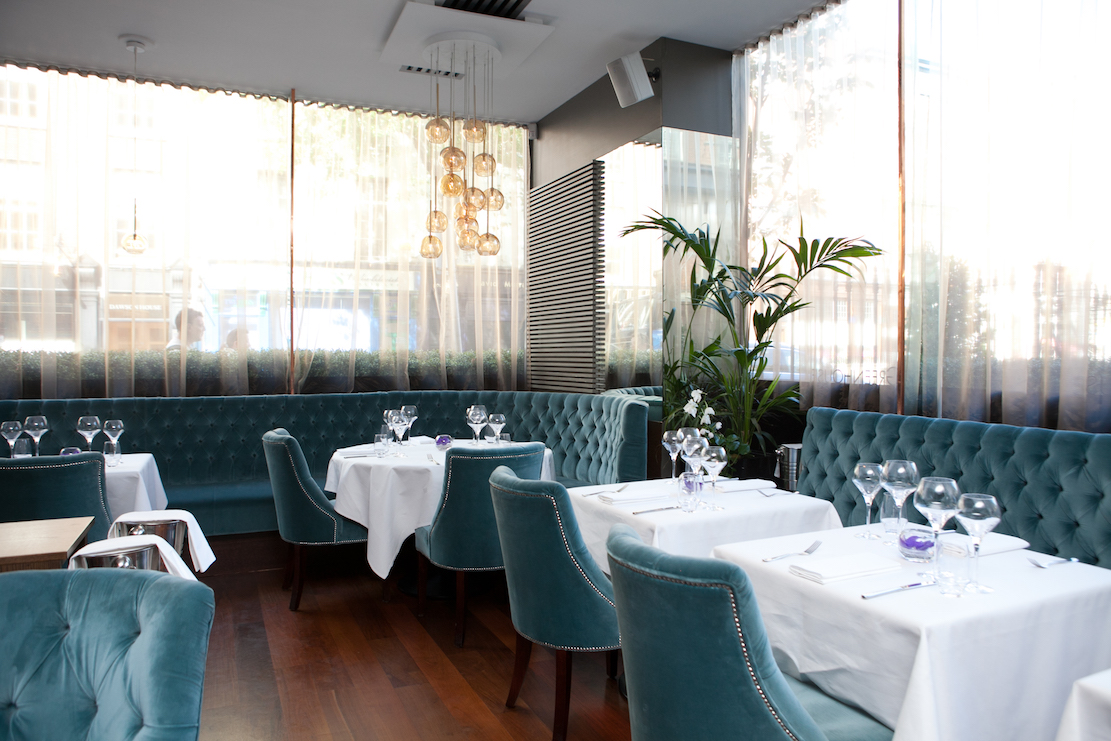
353-1-676-7015
If L’Ecrivain has a nose-to-nose
competitor in Dublin, it’s The Greenhouse,
opened in 2012 near St. Stephen’s Green, a
sedately decorated, small, quietly serviced
restaurant where, with only 40 seats that are
staggered in booking, a reservation is requisite
for dinner.
The
restaurant’s dedication to wine in unparalleled
and very well selected in all categories, though
many are priced high (see my note on wine prices
below). The website, by the way, is confusing, difficult
to navigate and amateurish for such a fine dining
experience.
 Mikael
Viljanen,
a Finn, likes fancy plating, sometimes a bit twee,
but it doesn’t detract from the flavors of the
food. My margin notes ran from “very good” to
“exceptional” throughout the meal, beginning with
a plump lobster raviolo (right), cabbage, trumpet mushrooms
and corn; a
carefully roasted
Mikael
Viljanen,
a Finn, likes fancy plating, sometimes a bit twee,
but it doesn’t detract from the flavors of the
food. My margin notes ran from “very good” to
“exceptional” throughout the meal, beginning with
a plump lobster raviolo (right), cabbage, trumpet mushrooms
and corn; a
carefully roasted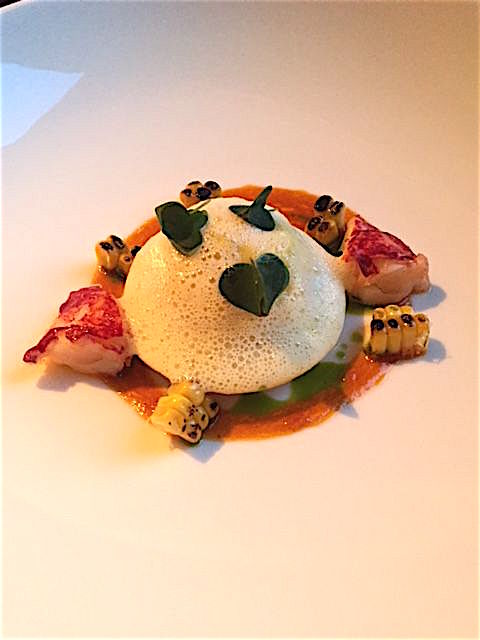 foie
gras, seared and buttery outside, soft and creamy
within, appended with sweet apple, the subtle
scent of sorrel, the surprise of smoked eel and
Riesling wine to cut the fat.
foie
gras, seared and buttery outside, soft and creamy
within, appended with sweet apple, the subtle
scent of sorrel, the surprise of smoked eel and
Riesling wine to cut the fat.
Exceptional indeed was a roast
seabass with crab, broccoli and lightly smoked
yogurt to enrich it, and Sika deer partnered with
Brussels sprouts, cèpe mushrooms, salsify and
blackberries.
There is a nice
selection of artisan cheeses, but as an extra
course at €18 it’s pricey. Caramel custard tart
with banana and hazelnut was delicious and equal
to the praline and milk chocolate cream with
citrus and salted milk sorbet.
You may begin an evening at The
Greenhouse in a somewhat hushed room, but after a
glass of wine and such splendid food, everyone
will be talking in admiration of what they are so
obviously enjoying. And there’s a good chance
you’ll begin chatting about the experience with
the next table over.
Open
Tues.-Sat. for lunch and dinner; 3 courses €69,
4 courses €79; 5 courses €85, with wines plus
€55 and €90.
ABOUT THOSE HIGH WINE PRICES IN DUBLIN. . .
A bottle of wine at a Dublin restaurant of every stripe may strike you as considerably higher than even Northern Ireland or London, but the reason, as explained by John Wilson in The Irish Times, is because “duties on wine in Ireland are among the highest in Europe. We pay excise duty of €3.19 on every bottle of wine, plus 23 percent VAT on top of that . . . Excise duties tend to distort pricing by more than simply the duty, as importers and retailers incorporate the excise in the cost of their wine before they add their profit margin, [making Ireland] the most expensive country in which to buy, even more so than Denmark, Sweden and Canada, all known for having very high duties and, in the case of the latter two, run by state monopolies.”
FOOD TOURS
Dublin seems to have a plethora of food tours
visitors may take, each with various options, and
I was able to go on two while there.
FAB FOOD TRAILS
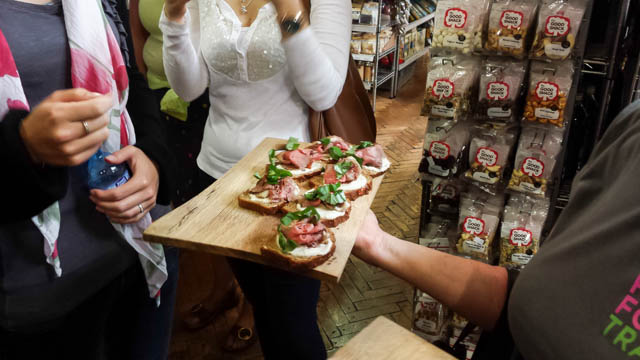 On a “gentle” three-hour stroll,
you will visit seven to eight different places,
all independently owned, tasting food and drink in
each place and meeting the purveyors or makers who
reflect “the current food scene, bringing new
international and contemporary tastes to the Irish
table and all using great Irish produce.”
On a “gentle” three-hour stroll,
you will visit seven to eight different places,
all independently owned, tasting food and drink in
each place and meeting the purveyors or makers who
reflect “the current food scene, bringing new
international and contemporary tastes to the Irish
table and all using great Irish produce.”
The luck of the Irish was upon
me with my guide Róisin Fallon, whose expertise,
flexibility and great enthusiasm never flagged as
we visited Powerscourt
food hall, Sheridans Cheesemongers, the Fallon
& Byrne Food Market and much else. If you sign
up, ask for her and you’ll have a friend forever.
Go
to: www.fabfoodtrails.ie
IRISH FOOD TRAIL
Paul Kavanagh’s Irish
Food Trail is a three-hour tour centered more on
pubs and restaurants, with a Deluxe Sunday option
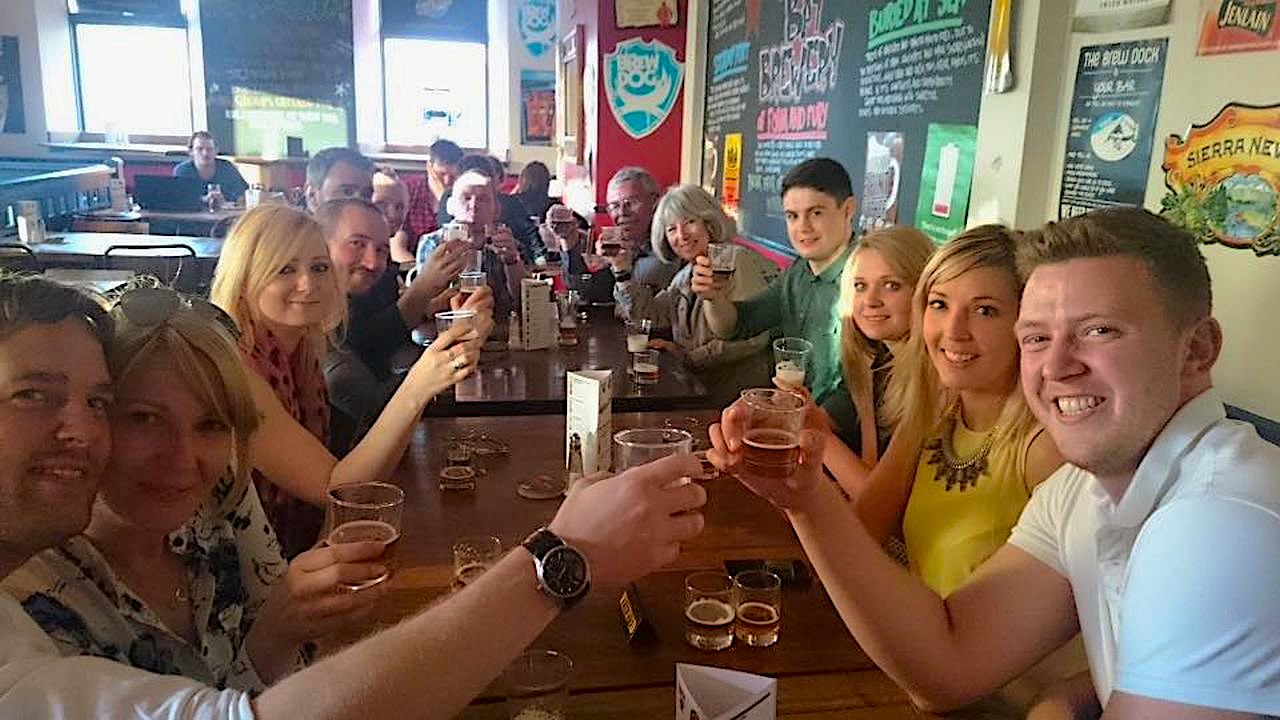 for high-end restaurants. You’ll
visit three restaurants, beer and wine included, meet
local people and experience the culture and
history of Dublin along the way, with groups of
four or more.
I was a lucky bloke indeed to join five
energetic American sisters on the tour, sharing a
fine traditional meal and Guinness at The Front
Door and ending at a lively pub-music club in
Temple Bar, where we got a lesson in making the
perfect Irish coffee. It’s likely by the end of
the tour and the drinks, everyone will feel like
brothers and sisters, no matter where you’re
from. Go to:
www.irishfoodtrail.ie
for high-end restaurants. You’ll
visit three restaurants, beer and wine included, meet
local people and experience the culture and
history of Dublin along the way, with groups of
four or more.
I was a lucky bloke indeed to join five
energetic American sisters on the tour, sharing a
fine traditional meal and Guinness at The Front
Door and ending at a lively pub-music club in
Temple Bar, where we got a lesson in making the
perfect Irish coffee. It’s likely by the end of
the tour and the drinks, everyone will feel like
brothers and sisters, no matter where you’re
from. Go to:
www.irishfoodtrail.ie
❖❖❖
By John Mariani

212-759-5941
For
a quarter century now Oceana has been a totem
for great seafood in NYC, a longevity that
guarantees its access and clout to buy the best
in the market.
Though not new to NYC, Bill Telepan,  following
eight years at his own namesake restaurant, is
the new chef, and while there are changes
throughout the menu, Oceana remains as exemplary
as ever within its own style.
following
eight years at his own namesake restaurant, is
the new chef, and while there are changes
throughout the menu, Oceana remains as exemplary
as ever within its own style.
Together with the Livanos
family (who also own the Greek restaurant
Molyvos), managing partner Paul McLaughlin has
kept Oceana, once located off Madison Avenue, as a
beacon of great modern design, beginning with an
oyster bar up front that is always packed by the
moment the clock strikes six. Beyond is a
beautiful, spacious dining room with a window onto
the brightly lighted kitchen where Telepan and his
team work to keep up with a constant flow of
regulars and newcomers, pre-theater and after.
You may also eat in a glassed-in
area flanking the kitchen, one of several private
dining options.
Photo by Paul Johnson
The menu has been somewhat
shortened, but there is still a wide selection of
oysters and crudi (below). Telepan has
brought over a few dishes 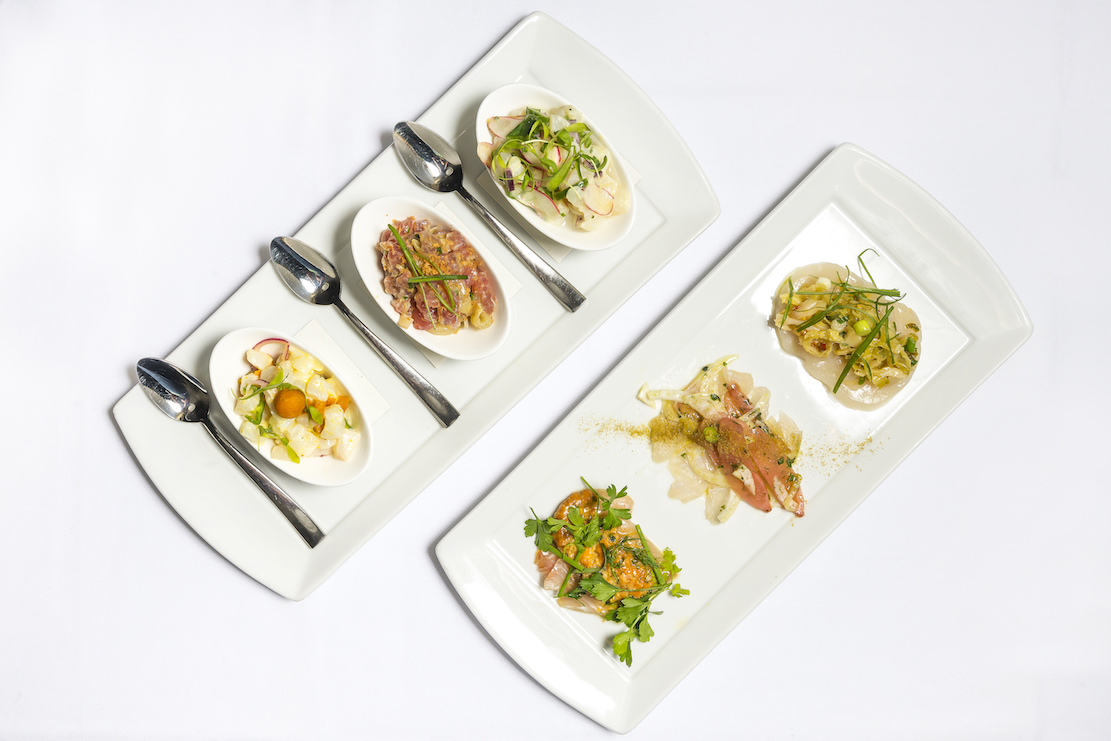 from his
former restaurant, and he’s also quite proud about
his porchetta-spiced pork chop with white beans
and roasted garlic ($38). Right now the oyster
list may include specimens ranging from Cape May
Salt, Hurricane Island, Pebble Beach, Wellesley
and Kusshi (all $3.50).
from his
former restaurant, and he’s also quite proud about
his porchetta-spiced pork chop with white beans
and roasted garlic ($38). Right now the oyster
list may include specimens ranging from Cape May
Salt, Hurricane Island, Pebble Beach, Wellesley
and Kusshi (all $3.50).
Photo by Noah Fecks
He was
kind enough to send out eight different crudi ($17-$23)
that included yellowtail,
sea urchin and a mild dose of horseradish; tuna
tartare with pickled mushrooms, cippolini and bottarga
roe; marvelous, sweet bay scallops with green
apple, kohlrabi and sumac; black sea bass, caviar
and lemon aïoli; a sea scallop with hot kimchi
vinaigrette; razor clams in squid ink and tangy
blood orange; a halibut ceviche with spicy
sunchoke and orange; and steak tartare, with a
deviled egg sauce and preserved lemon.
There are now three pastas on the
menu, including stracci
(rags) with a bountiful amount of Gulf shrimp and
stracciatella,
cabbage and basil ($25/$35). The lobster Bolognese
($30-$40) is a hold-over from Telepan, and while
it’s good, it’s a bit overwrought, and I can’t
figure why it’s dubbed “Bolognese.”
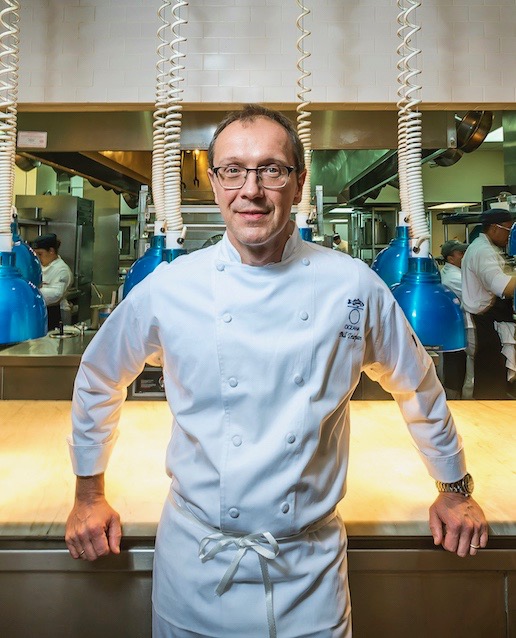 Photo
by Noah Fecks
Photo
by Noah Fecks
Among
the appetizers we tried there were four baked
oysters judiciously seasoned with bacon, garlic
and oregano ($20), and grilled octopus with a nice
hit of shishito pepper and a welcome acidic splash
of celery vinaigrette ($21). There’s no disputing
the amount of lump meat in the crabcakes with
spicy cole slaw and good, old-fashioned Green
Goddess dressing ($22), though I might wish for
the larger jumbo lump of a kind I’d find in a good
seaside eatery in Maryland. 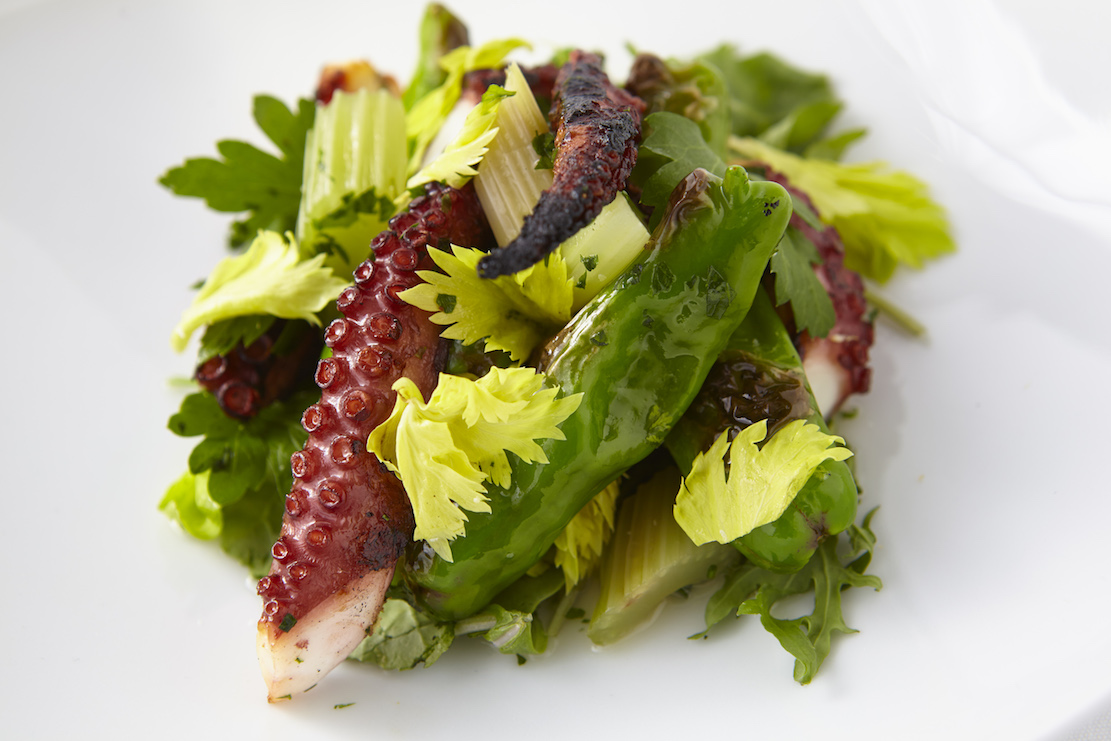
When swordfish is at its best
it is a terrific slice of goodness and that night
it was a lustrous beauty, with pickled lemon,
escarole and a delightful black pepper yogurt
($42); so, too, was the seared halibut—more
flavorful than most in NYC—with crushed sunchoke,
wild mushrooms and spinach ($42); almost
translucent sea scallops took on the perfect
additions of orange, carrots and a side of fried
polenta ($44).
Photo by Paul Johnson
I did question Telepan as to
why he’s serving farm-raised Scottish salmon
rather than wild, and he said it was a question of
price. But,
hey, this is Oceana and this is NYC; if you serve
the best it has to be in every category. Anyway,
his salmon is crusted with lemon and served with salade frites,
herb aïoli and lemon-pepper salt ($40).
Pastry
chef Douglas Hernandez fits his lavish desserts
impeccably into the Oceana style, as with his
tropical vacherin with a lime meringue, coconut
ice cream, pineapple granité, macerated tropical
fruit and prosecco lime gelée ($12); a
not-too-dense chocolate bar with a hazelnut crust,
Nutella powder, candied cocoa nibs, candied
pistachios, chocolate meringue, white chocolate crèmeux
and chocolate sorbet ($15); and an orange
Dreamsicle parfait of orange cream, olive oil
cake, oatmeal crumble and orange foam ($12). The
signature Oceana cookie plate ($12/$21) remains in
place.
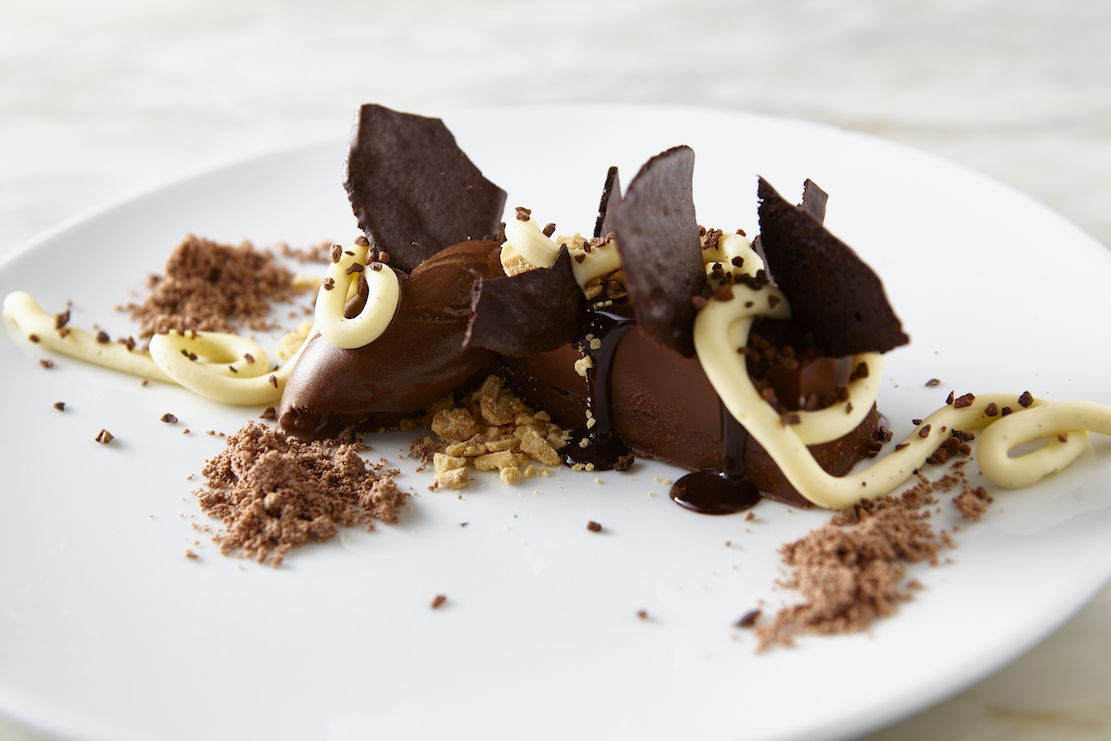 There’s
also a new wine director onboard, Adam Petronzio,
who stocks 600
selections and 24 wines by the glass, with $26 the
highest price, for Pierre Gerbais Champagne; still
wines run $10-$20.
There’s
also a new wine director onboard, Adam Petronzio,
who stocks 600
selections and 24 wines by the glass, with $26 the
highest price, for Pierre Gerbais Champagne; still
wines run $10-$20.
Oceana has achieved a
remarkable feat, for not only does 25 years in
business make it a bonafide NYC classic that has
maintained a highly diverse clientele but that it
has managed to evolve with the times without
losing its original spirit, which from the
beginning was always based on innovation. That,
and the personal attention of Paul McLaughlin and
his staff, puts Oceana in the top rank of what NYC
restaurants truly represent.
Photo by Paul Johnson
Oceana is open for breakfast and lunch
Mon.-Fri., for dinner Mon.-Sat. In addition to a
la carte, there is a chef’s tasting menu at $95.
❖❖❖
PURPLE HEART WINES

By John Mariani
For
a half century now the Purple Heart
Foundation has been supporting and honoring the
sacrifice military veterans have made for our
country by helping more than19,000 veterans. To
contribute to such work is a privilege for those
who can, and in the wine world, no one is better
positioned to make a mark than Vietnam vet Ray
Coursen and Iraq war vet David Grega.
Coursen (below)
founded Elyse Winery in Rutherford, California,
in 1997 and a decade later purchased a small
winery and vineyard adjacent to the C. Mondavi
family’s Yountville Vineyards. Having
gained a reputation for overseeing the creation
of more than 50 well-regarded wines, Coursen was
approached by the Mondavi family to collaborate
on a charity wine to benefit veterans through
the Purple Heart Foundation.
“I didn’t hesitate for a
second,” Coursen told me over a steaks and chops
dinner in New York. “Any way I could use my
expertise to honor those brave men was what I
most wanted to do. I came home unharmed, many
did not. So working with the people at Mondavi
allows me all the leeway necessary to make the
best wine I can, not just some commemorative
bottling with a pretty label. I’ve been able to
source fruit right from the family’s vineyards
to make a premium merlot-based wine that would
sell for $20 so that it was within a veteran’s
budget.”
 It as a
sentiment that wholly jibed with the Mondavi
family’s intent: “We are proud to make an annual
donation to the Purple Heart Foundation, an
organization dedicated to serving the unmet
needs of military men, women and families. Our
military personnel make huge sacrifices. When
crafting this wine, we made no sacrifices. It is
an uncompromising wine made under the close
stewardship of the Peter Mondavi Sr. Family,
whose patriarch is a proud veteran of World War
II. Join us as we lift a glass and pay tribute
to our brave military heroes and thank them for
their profound contributions.”
It as a
sentiment that wholly jibed with the Mondavi
family’s intent: “We are proud to make an annual
donation to the Purple Heart Foundation, an
organization dedicated to serving the unmet
needs of military men, women and families. Our
military personnel make huge sacrifices. When
crafting this wine, we made no sacrifices. It is
an uncompromising wine made under the close
stewardship of the Peter Mondavi Sr. Family,
whose patriarch is a proud veteran of World War
II. Join us as we lift a glass and pay tribute
to our brave military heroes and thank them for
their profound contributions.”
Coursen, 68, grew up on a New
Jersey farm, was drafted into the U.S. Army in
1968 and served two years, afterwards touring
Europe, where he began his love affair with
wine. On
returning home he enrolled at UMass
Amherst’s Stockbridge School of Agriculture,
tended bar and worked at a fine wine shop
in Boston, where his passion for wine soared.
With his wife, Nancy, Coursen moved to
California in 1982, working from the bottom up
to learn the wine business, especially at White
Hall Lane under winemaker Art Finkelstein.
Buying Elyse Winery was a dream realized; making
wines for the Purple Heart charity has made it
all the sweeter.
The first vintage, 2013,
debuted with representatives from the Mondavi
family and the Purple Heart Foundation gathered at
the Intrepid
Sea, Air and Space Museum in New York, with the
presentation of a $10,000 check to the
foundation and a promise to donate up to $50,000
annually in future years. Only
7,200 cases were made and the wines sold out
fast.
A
year later winemaker David Grega joined the
effort. He
had served in Iraq, returned home to Northern
California, caught wine fever in 2008 and
launched Carlotta Cellars and Broken Arrow Wines
in 2011, as well as being Assistant Winemaker
for brands like TOR Kenward, Rudius, Boich
Family Cellars, Anthem Winery and others.
I was able to taste the wines
with Coursen and found them very admirable,
especially at the $20 price point. They
had good complexity and the alcohol, at 14.2
percent, was not too high, ideal with the strip
steak and Colorado lamb chops we enjoyed that
evening. The 2013 is a blend of Merlot, Cabernet Sauvignon, Cab
Franc and
Petit Verdot, resembling a sturdy Pomerol, as is
the 2014, with some Petite Syrah added in, of
which 1,500 cases have been
produced.
Such wines don’t deserve
write-ups like the one that tried to force tacky
metaphors on a serious effort, like “Whether
you’re the Grill Sergeant or the Drill Sergeant
at the barbecue, take command with this
dark-ruby colored and fruit-forward Bordeaux
blend.” These
are wines that demand respect for their
character and their honesty, good wines at a
good price for a very, very good cause.
Purple Heart wines can be ordered on line at https://www.purpleheartwines.com/product/2014-purple-heart-red-wine/
❖❖❖
TELL ME WHAT YOU EAT AND 
I'LL TELL YOU
WHAT YOU ARE.
One of
Spain's top restaurants, El Celler de Can Roca, is
trying to help employees cope with their high-pressure
stress by hiring a staff psychologist named Inma Puig, a
therapist whose clinical expertise is in teamwork
morale. According to the NY Times, Joan Roca, one of El Celler’s
three chef-owner brothers, notes, the kitchen has
“a lot of people working at high speed, very close to
each other — and with a knife in their hand.”
 FOOD WRITING
101: Making the word "Panzer" into a verb is the act
of an imbecile, as is the rest of the following
sentence.
FOOD WRITING
101: Making the word "Panzer" into a verb is the act
of an imbecile, as is the rest of the following
sentence.
“As
‘fast
casual’ panzers over our dining a landscape, restaurant
L is nothing short of radical. It’s a throwback that’s
also ahead of the curve: at once a grand dame and an
outlandish upstart, Hollywood Regency glamour meats New
York City kick ass.”—“Restaurant L,” Cincinnati
Magazine (March, 2017).
Any of John Mariani's books below may be ordered from amazon.com.
 The
Hound in Heaven (21st Century Lion Books)
is a novella, and for anyone who loves dogs,
Christmas, romance, inspiration, even the supernatural, I
hope you'll find this to be a treasured favorite.
The story concerns how, after a New England teacher,
his wife and their two daughters adopt a stray puppy found
in their barn in northern Maine, their lives seem full of
promise. But when tragedy strikes, their wonderful dog
Lazarus and the spirit of Christmas are the only things
that may bring his master back from the edge of
despair.
The
Hound in Heaven (21st Century Lion Books)
is a novella, and for anyone who loves dogs,
Christmas, romance, inspiration, even the supernatural, I
hope you'll find this to be a treasured favorite.
The story concerns how, after a New England teacher,
his wife and their two daughters adopt a stray puppy found
in their barn in northern Maine, their lives seem full of
promise. But when tragedy strikes, their wonderful dog
Lazarus and the spirit of Christmas are the only things
that may bring his master back from the edge of
despair. WATCH THE VIDEO!
“What a huge surprise turn this story took! I was completely stunned! I truly enjoyed this book and its message.” – Actress Ali MacGraw
“He had me at Page One. The amount of heart, human insight, soul searching, and deft literary strength that John Mariani pours into this airtight novella is vertigo-inducing. Perhaps ‘wow’ would be the best comment.” – James Dalessandro, author of Bohemian Heart and 1906.
“John Mariani’s Hound in Heaven starts with a well-painted portrayal of an American family, along with the requisite dog. A surprise event flips the action of the novel and captures us for a voyage leading to a hopeful and heart-warming message. A page turning, one sitting read, it’s the perfect antidote for the winter and promotion of holiday celebration.” – Ann Pearlman, author of The Christmas Cookie Club and A Gift for my Sister.
“John Mariani’s concise, achingly beautiful novella pulls a literary rabbit out of a hat – a mash-up of the cosmic and the intimate, the tragic and the heart-warming – a Christmas tale for all ages, and all faiths. Read it to your children, read it to yourself… but read it. Early and often. Highly recommended.” – Jay Bonansinga, New York Times bestselling author of Pinkerton’s War, The Sinking of The Eastland, and The Walking Dead: The Road To Woodbury.
“Amazing things happen when you open your heart to an animal. The Hound in Heaven delivers a powerful story of healing that is forged in the spiritual relationship between a man and his best friend. The book brings a message of hope that can enrich our images of family, love, and loss.” – Dr. Barbara Royal, author of The Royal Treatment.
 |
The Encyclopedia of American Food and Drink by John F. Mariani (Bloomsbury USA, $35) Modesty forbids me to praise my own new book, but let me proudly say that it is an extensive revision of the 4th edition that appeared more than a decade ago, before locavores, molecular cuisine, modernist cuisine, the Food Network and so much more, now included. Word origins have been completely updated, as have per capita consumption and production stats. Most important, for the first time since publication in the 1980s, the book includes more than 100 biographies of Americans who have changed the way we cook, eat and drink -- from Fannie Farmer and Julia Child to Robert Mondavi and Thomas Keller. "This book is amazing! It has entries for everything from `abalone' to `zwieback,' plus more than 500 recipes for classic American dishes and drinks."--Devra First, The Boston Globe. "Much needed in any kitchen library."--Bon Appetit. |
"Eating Italian will never be the same after reading John Mariani's entertaining and savory gastronomical history of the cuisine of Italy and how it won over appetites worldwide. . . . This book is such a tasteful narrative that it will literally make you hungry for Italian food and arouse your appetite for gastronomical history."--Don Oldenburg, USA Today. "Italian
restaurants--some good, some glitzy--far
outnumber their French rivals. Many of
these establishments are zestfully described
in How Italian Food Conquered the World, an
entertaining and fact-filled chronicle by
food-and-wine correspondent John F.
Mariani."--Aram Bakshian Jr., Wall Street
Journal.
"Equal parts
history, sociology, gastronomy, and just
plain fun, How Italian Food Conquered the
World tells the captivating and delicious
story of the (let's face it) everybody's
favorite cuisine with clarity, verve and
more than one surprise."--Colman Andrews,
editorial director of The Daily
Meal.com. "A fantastic and fascinating
read, covering everything from the influence
of Venice's spice trade to the impact of
Italian immigrants in America and the
evolution of alta cucina. This book will
serve as a terrific resource to anyone
interested in the real story of Italian
food."--Mary Ann Esposito, host of PBS-TV's
Ciao
Italia. "John Mariani has written the
definitive history of how Italians won their
way into our hearts, minds, and
stomachs. It's a story of pleasure over
pomp and taste over technique."--Danny Meyer,
owner of NYC restaurants Union Square
Cafe, The Modern, and Maialino.
|
 |
 |
 |
 |
 |
 |
 |
 |
 Everett Potter's Travel Report:
Everett Potter's Travel Report: 
 Eating Las Vegas
JOHN CURTAS has been covering the Las Vegas
food and restaurant scene since 1995. He is
the co-author of EATING LAS VEGAS – The 50
Essential Restaurant, as well as
the author of the Eating Las Vegas web site: www.eatinglasvegas.
He can also be seen every Friday morning as
the “resident foodie” for Wake Up With the
Wagners on KSNV TV (NBC) Channel 3 in
Las Vegas.
Eating Las Vegas
JOHN CURTAS has been covering the Las Vegas
food and restaurant scene since 1995. He is
the co-author of EATING LAS VEGAS – The 50
Essential Restaurant, as well as
the author of the Eating Las Vegas web site: www.eatinglasvegas.
He can also be seen every Friday morning as
the “resident foodie” for Wake Up With the
Wagners on KSNV TV (NBC) Channel 3 in
Las Vegas.

MARIANI'S VIRTUAL GOURMET
NEWSLETTER is published weekly. Editor/Publisher: John
Mariani.
Editor: Walter Bagley. Contributing Writers: Christopher Mariani,
Robert Mariani, Misha Mariani, John A. Curtas, Geoff Kalish, Mort
Hochstein, and
Brian Freedman. Contributing Photographers: Galina
Dargery. Technical Advisor: Gerry McLoughlin.
To un-subscribe from this newsletter,click here.
© copyright John Mariani 2017

